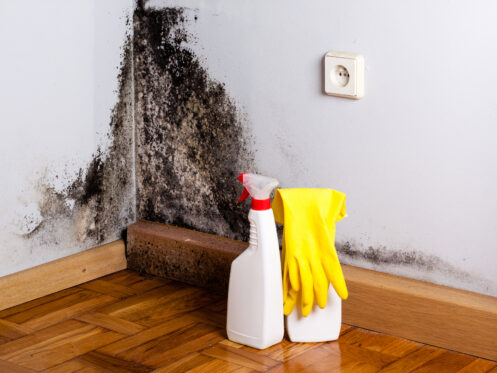Mold and mildew growth is a common issue found in many bathrooms. Not only is having mold on your tiles or around your bathtub or shower unsightly, but it can also give off an unpleasant odor and make your bathroom smell dirty and musty. Preventing mold and mildew from growing in your bathroom really isn’t that difficult as long as you’re proactive and follow these simple tips.
1. Always Run the Exhaust Fan When Bathing
Taking a shower or a bath always produces lots of steam. If you don’t turn on the exhaust fan in your bathroom before you shower or bathe, the moisture can start to soak into your walls and greatly increase the chances of mold and mildew forming. It is also important that you don’t turn the fan off on your way out of the bathroom once you’re done since lots of steam and moisture will still be present in the air. Ideally, you’ll want to leave the fan running for at least 30 minutes after showering or taking a bath whenever possible.
It is also important that your fan is powerful enough for the size of your bathroom and that it works properly. Dust and debris will always collect on the fan over time, so it’s a good idea to get into the habit of cleaning off the cover or intake every time you clean the bathroom. You should also periodically test your fan to ensure that it’s still functioning effectively. The easiest way to do this is to take a square of toilet paper and hold it up to the fan intake. When the fan is working as effectively, the toilet paper will get sucked up against the intake and stay in place until you turn the fan off. If this doesn’t happen, you may need to have the fan replaced or the inside of it cleaned out.
If your bathroom doesn’t have a fan or you need to replace the existing one, it is important that whatever you choose is powerful enough to work effectively. All exhaust fans are rated based on how many cubic feet of air they can move per minute (CFM). To determine what CFM the fan needs to be to work effectively, you’ll need to measure the size of your bathroom to first find the square footage. From there, you can then multiply the square footage by 1.1 to calculate the cubic feet or total air volume of a room with an 8-foot ceiling. If your bathroom has a 9-foot ceiling, you should multiply the square footage by 1.5 instead.
2. Open the Window and Door After Bathing
Even if you leave the exhaust fan running, it is also a good idea to leave the door to the bathroom open after you shower to help the moisture dissipate more quickly. If you have a window in your bathroom, open it when you’re done. In this case, you may want to leave the door closed so that all of the air coming in through the window doesn’t heat up or cool down the rest of your house.
3. Use a Squeegee or Towel to Keep Everything Dry
Running the exhaust fan and opening the door or window will help to remove moisture and keep condensation from forming, but you also want to make sure you dry everything off as well as you can every time you use the bathroom. This means drying around the sink after washing your hands or brushing your teeth if you splashed any water up on top of it or around the caulk or grout. If you have a shower-tub combo, you’ll also want to use a towel or washcloth and dry around the entire top rim. A squeegee will help prevent mold in a walk-in shower as it makes it easy to get rid of all of the water on the walls, door, and floor. It’s especially important that water doesn’t sit on the grout in between tiles and the caulk or silicone used to seal around the edges of the sink, bathtub, and shower since these are the places that are most prone to mold and mildew.
4. Spray Down Your Shower Daily
If you don’t want to deal with the hassle of having to squeegee and dry off the inside of your shower, you can spray it down a bathroom cleaner or shower spray once you’re done. Most bathroom cleaners are designed to prevent mold and mildew growth, but vinegar generally works just as well. In fact, vinegar can be even more effective as it will also help to eliminate soap scum, mineral deposits, and water spots.
5. Make Sure That Caulk and Grout Isn’t Cracked
Caulk and grout are specially designed to create a water-tight seal. However, they tend to degrade and start cracking over time. If they are cracked, water will start seeping in and getting trapped, which can quickly lead to mold and mildew forming. Vinegar or any cleaning product that kills mold and mildew will get rid of the problem, but it is only a temporary fix as the mold and mildew will quickly return.
If you’re having lots of issues with mold and mildew in between the tiles or around the edge of sinks, showers, and tubs, you’ll want to have the caulk replaced or the tiles regrouted. Grout usually only lasts for eight to 10 years, so it’s a good idea to consider having your bathroom regrouted to ensure mold and mildew don’t become a problem.
6. Clean Any Visible Mold and Mildew Spots Immediately
If you ever notice that you have issues with mold and mildew in the bathroom, clean everything immediately. Mold and mildew are both fungi, and they constantly send out lots of spores that allow them to spread to other places. This is why you need to be proactive so that you can prevent the problem from spreading. Cleaning any spots off of tile or porcelain is fairly easy and can be done with just a rag and cleaning spray. If mold stuck to the grout or caulk, spray everything and let it sit for at least 10 minutes. Once it has soaked in, you can then use a toothbrush or any other soft-bristled brush to gently scour everything away. After you’re finished, it’s again important to make sure you fully dry everything off.
7. Wash All Bathroom Items Regularly
Bathroom mats, towels, and shower curtains tend to stay wet for a long time and can easily start growing mold. This can again lead to the mold spreading due to all of the spores it sends out. This is why you should always make sure to hang towels, loofahs, and sponges up so that they fully dry. Wash your mats and shower curtains weekly, too. If you don’t want to take the shower curtain down, you can also just spray it with vinegar or bathroom cleaner and then wipe it clean every week or two.
8. Make Sure There Are No Leaks
This last tip is quite obvious, but it is important to regularly check your bathroom to make sure that none of the plumbing fixtures are leaking. This means checking for water, discoloration, and mold around the toilet and underneath the bathroom sink cabinet or vanity. If you notice that the flooring near your toilet, shower, or bathtub feels spongy or soft, contact a plumber immediately since this indicates that the drain is leaking and water is seeping underneath the flooring.
If you’re dealing with a leak or need any other plumbing service, you can count on Plumbing & Cooling Nerds for help. We have offices in Naples, Cape Coral, Bonita Springs, and Fort Myers, so give us a call for all of your plumbing and HVAC needs in Southwest Florida.

